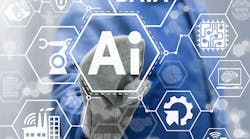I believe that artificial intelligence (AI), machine learning (ML), Bayesian optimization, big data and other contemporary techniques can improve our ability to model, understand and optimize processes; and that these techniques can move industry toward autonomy of operation and maintenance. These are core elements within the buzzwords of Industry 4.0, the Industrial Internet of Things (IIoT), smart manufacturing, smart instrumentation, asset models and digital twins. AI solutions are promoted by vendors, perhaps with an intensity needed to overcome process owner cautions, but also with a hype that might even create skepticism among potential users. How do we generate acceptance and sort out appropriate applications? How do we accelerate progress? Maybe this article can help.
An introduction
AI is a set of deterministic algorithms for modeling or searching through a vast database with today’s computer-enabled techniques. Our personal devices take voice commands, and autocorrect our spelling and grammar. They “listen” to voiced questions and provide “answers” such as “I found this about that.” But the listening is not human-like understanding, it's just algorithmic translation of soundwaves. And the responses are just connections to websites with possible answers to the text translation of key words in the question. Thirty years ago, all that would have been science fiction.
Although AI may seem remarkable, it's not a human-type of intellect. It's not an existence that has needs that drive its independent actions. It doesn't have an agenda that might undermine the human’s. Despite its name, despite the vision that developers have been pursuing, and despite fictional creativity, AI is not an independent intellect.
ML does not “learn” like a human learns. There is no machine understanding or comprehension. ML is just a collection of computer-enabled techniques for finding relations (like principal component analysis) or adjusting model coefficients to make the model best match the data (like regression). One could go back in time and present regression as “learning,” and mystify people who don't understand regression. ML does not learn or understand as a human does.
Partly, the science fiction terminology, mystery, and creator exuberance of those exploring and developing AI create misunderstanding among potential users, leading to either of two wrong directions. One is a fear of what this alien mind might do if left in charge. The second is the expectation that AI will magically solve everything. However, like any advance in modeling and analysis that's supported process designers and operators in the past, AI is just today’s computer-enabled set of aids to human understanding, control and improvement of processes.
In the 1970s, the cruise control on my car was proportional-only, leaving a steady-state offset when going up or down a long hill (it was fun to mentally match the offset to the road slope). In the 1980s, they added an integral feature to remove that offset. Now, my automaker calls its cruise control product “Intelligent Control.” When it detects the presence of a vehicle in front, it reduces speed to preserve a safe distance, and when I move to the passing lane, it returns to the setpoint speed. These advances weren'y magic or cognitive. However, today’s fashion is to call advanced technical features intelligent or smart.
I believe that AI has much to offer by supporting human efforts to control, optimize, safely operate, and better understand the processes that we use. I also think we need to have rational expectations of what AI can do, and take as much caution in implementing AI as we do in giving autonomy to novice human employees.
In this article, I'll discuss how AI might support the human agenda in managing processes, and provide my view of what users and vendors need to do to explore its potential. I'm also asking users and vendors to write to Control ([email protected] is a receptive ear) about how they've solved implementation and application issues.
Two key issues that I see are: 1) generating trust and 2) application design. Let me explain.
Responsible charge: One of the major barriers, in my experience, to computer autonomy in the process industry is the fact that managers are in responsible charge. They're personally accountable for undesirable events such as environmental violations, injury to people or losses. The concerning issues include safety, compliance with contracts and regulations, coping with unexpected outcomes, and immediate return to safe operation should a possible threat begin to appear. Managers are risk-adverse. There's always the unexpected. They don't place their career and life in the care of novice employees, whose initial solutions are usually myopic. I think management will be less trusting that AI will contain all-inclusive situational awareness than they would be of a novice human.
Application design: When we design a new process, system or method, we usually don’t get it right the first time. It's the same with writing paragraphs and reports, or when planning an event. As we think about it, we fine tune to improve, incorporate new features that weren't initially considered, and eventually get a design that works. Novices are less able to get it close on a first try. In my experience, it's the same in designing an AI application. The first try is simplistic, and often presumes that the AI has an ability that it does not. AI requires substantial human guidance. You need to choose what data to give it, have reasonable expectations as to what it can find in the data, and how complete the understanding of any output decisions will be.
For those who would promote AI
Whether you're a vendor or a potential user seeking to convince management to try AI, I suggest this list to gain its acceptance:
- Explain how it works. Make potential users and managers feel safe. Don't cast AI as sentient, intelligence or mysterious. Don't use computer and data scientist language or human-like attributions. Don't mask the algorithm mechanism by redirecting the customer’s focus to how great or easy it is to use. Explain the algorithm. Include what it can't do as well as what it can. Make sure the buyer understands.
- AI includes many new-era modeling and optimization algorithms. Are they better than traditional methods? Is the benefit (functionality, accuracy, speed, understandability) relative to the cost (data acquisition, training, software) enough to justify its use? Don’t buy in because they're touted as better or because it's the new fashion. Potential users should test to see if it's better for a target application.
- Vendors should provide benchmark tests on user-oriented applications with user-oriented metrics of goodness, not inventor-oriented metrics obtained by using academic examples. Establish credibility within the potential user’s values, not those of the inventors’ scientific journal community.
- Fit the application to the technique. “For a person with a hammer, everything looks like a nail” (a 1960s adage variously attributed to Maslow, Kaplan and Baruch). If you explore something good, but on the wrong application, or with incomplete ability to implement it, then the outcome will be a failure. As it happened with neural networks in the 1980s, the something good will earn the reputation “it doesn’t work.” It takes a very long time for a good thing to recover from such a reputation. Let’s not undermine AI by letting it be misapplied.
- Apply AI in incremental stages. Don't initially propose to give autonomy to the AI, but have it report what it would recommend doing. Let operators implement the recommendation if they agree. Keep the humans in the loop, progressively including comprehensive issues to the initial myopic solution. Establish confidence in incremental steps.
- Process owners need to add or adjust considerations for AI autonomy as human understanding of process and automation applications evolve. Consequently, AI providers need to make it easy for humans to adjust artificial intelligence from an initial myopic view of what the situation is all about to a more synoptic view of all the new issues that are being included—to determine the true, comprehensive, multifaceted objective.
Needs and opportunities for AI
Maybe one day AI will be able to autonomously diagnose and control real-world operations. Publicized applications include cars, manufacturing, medicine and many others. However, here's my wish list of what I consider practical for AI in process-industry applications:
It certainly would be nice to use the same model in all applications. We use models for design, training, control and optimization, and it would be nice to have one model, common to all uses.
It would be nice if AI could autonomously devise and adapt the models to match the target process as process attributes change in time. Necessarily, this includes autonomous pre- and post-processing validation of data.
In process control, we'd like to optimize the economic path rather than just the setpoints. This may include automated tuning of controllers, not just to minimize a squared deviation, but to minimize the operating cost of a transient subject to safety and product specification constraints.
It would be nice if voice commands could activate processes and voiced notes could be converted to text and placed in operators’ logs.
AI needs to cope with stochastic data. Processes aren't deterministic; they're noisy and subject to disturbances. We don't want a phantom “best” to misdirect the AI decision or output. AI also needs to make global decisions within constraints and discontinuities without getting stuck in local traps.
Support predictive maintenance by forecasting when deterioration needs to be fixed. This may be for machine maintenance or adjustment of models in optimization, process analysis, inferential measurement or control.
Convert linguistic rules of human perception about process behavior into code, validate (or reject) and improve the rules autonomously, then present validated and improved rules in human language to the process owners to help them better understand and manage their processes.
An invitation
As either a user or a vendor, what are you doing to remove the barriers to the application potential for AI? What do you see as the best opportunities for AI applications in the process industry? Again, let the editor know at [email protected]. We look forward to hearing from you, and will compile your responses in an upcoming issue.






